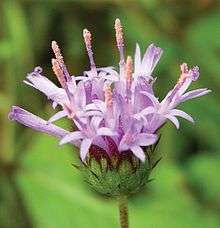Camchaya
Camchaya is a genus of flowering plants in the family Asteraceae. They are native to Asia, including China, Laos, Thailand, Vietnam,[2] and Cambodia.[3][3]
| Camchaya | |
|---|---|
 | |
| Camchaya thailandica | |
| Scientific classification | |
| Kingdom: | |
| (unranked): | |
| (unranked): | |
| (unranked): | |
| Order: | |
| Family: | |
| Subfamily: | |
| Tribe: | |
| Genus: | Camchaya |
| Type species | |
| Camchaya kampotensis | |
| Synonyms[1] | |
| |
These are annual herbs with coatings of hairs and globose glandular structures. The alternately arranged leaves have wavy or serrated blades on petioles. The inflorescence is a panicle[2] which can be terminal or axillary.[3] Some inflorescences have few flower heads, and some heads are solitary. The hemispherical head has up to 6 layers of phyllaries. It contains many purple florets which are tubular and expanded at the mouth into five pointed lobes and bear a long, branching style. The fruit is a compressed achene, usually with ten ribs, but sometimes with five. Some achenes have a pappus of up to 10 fragile bristles.[2] The pollen of plants in the genus has a unique "6-porate echinolophate" morphology.[3]
- Accepted species[3]
The following list reflects species accepted by The Plant List[4] and the Global Compositae Checklist.[1] Some recent publications suggest moving some of these taxa to other genera (Vernonia and Iodocephalopsis).[5][6]
References
- "Flann, C (ed) 2009+ Global Compositae Checklist". Archived from the original on 2014-11-11. Retrieved 2014-11-11.
- Camchaya. Flora of China.
- Bunwong, S., et al. (2012). A new species of Camchaya (Asteraceae, Vernonieae) from Thailand. PhytoKeys 12: 53–57.
- The Plant List search for Camchaya
- Bunwong, S., et al. (2009). Taxonomic notes on Camchaya and Iodocephalus (Vernonieae: Asteraceae), and a new genus Iodocephalopsis. Archived 2013-11-02 at the Wayback Machine Proceedings of the Biological Society of Washington 122(3), 357–63.
- Bunwong, S.; Chantaranothai, P.; Keeley, S. C. (2012). "A new species of Camchaya (Asteraceae, Vernonieae) from Thailand". PhytoKeys. 12 (12): 53–57. doi:10.3897/phytokeys.12.3221. PMC 3349056. PMID 22645414.